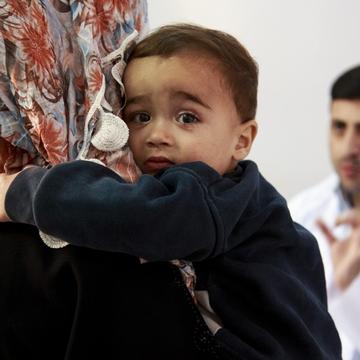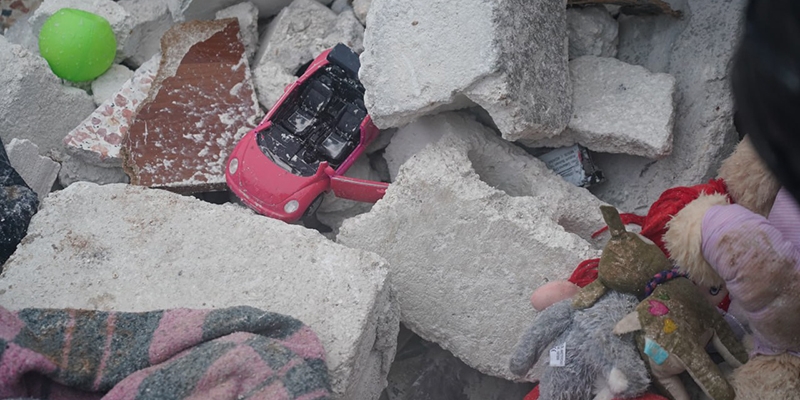Syrian Refugee Children Stories: Life as a Refugee
As Syria faces a critical turning point with cautious optimism for the future, the needs of children have never been higher.
Nearly 14 years of conflict and economic crises have left about 16.7 million people—nearly two thirds of the population—in need of assistance. The 2023 earthquakes that struck the country compounded the already dire humanitarian crisis.
More than one million people have fled their homes in recent days, following the events of November 27, 2024 when renewed fighting broke out. The escalation of conflict has lead to displacement, civilian casualties, suspension of classes in schools and universities in Idlib and the western Aleppo countryside,
Save the Children has been providing assistance to children in need in Syria since 2012. Our programming aims to reach every last child in need but we can't do it alone. This is a pivotal moment. Hope for Syria’s children is within reach, but their struggles are far from over.
Your donation today can ensure this turning point leads to lasting change, peace, stability and a brighter future for every child.

Dima* and her son Salim* at a Save the Children health center in northern Syria. Photo by Ahmad Baroudi.
Salim’s Story: Fighting to Survive the Winter in a Refugee Camp
In the midst of a bitter winter, Salim*, age 2, tries to stay warm at a refugee camp near the Syrian border. With temperatures nearing sub-zero, Salim will face this brutal winter in a snow-covered tent with only the clothes on his back to keep warm.
The cold days are long, but the nights are always longer for Salim. When the sun goes down, the temperature drops, and he can feel the freezing air against his cheeks. He shivers to keep his body warm but with no blanket he has nothing to protect him from the cold air breezing through the tent. He is one of many children fighting to survive the winter in a refugee camp, and as the conditions turn treacherous, he is in desperate need of warm clothes, blankets and food.
Children are the most vulnerable in refugee camps. They have been taken away from their homes, schools, friends and families, and have been forced to start new lives in strange environments. Save the Children is on the ground year round, providing the basics – like food and blankets – offering programs to help them cope with tragedy. We have also established temporary learning centers where children can continue their education in safe and quality learning centers. With your help children like Salim can get the supplies he needs to survive the winter, receive an education and learn to be a kid again.
A Syrian Refugee Puts Others Ahead of Himself
Despite his conditions of living as a Syrian child refugee, Ahmed* runs the World Marathon Challenge in Iraq to protect the health of other children.
Ahmed is one of the many Syrian children who had to flee their homes when the violence started inside Syria. Now Ahmed lives in a camp on the northern Iraqi border that was built for 10,000 and now holds close to 50,000 people-- almost half of them children.
This winter, too many children are living in freezing conditions in refugee camps – many having fled war-torn Syria with nothing but their summer clothes. Now living among frigid dunes, thousands of children are in desperate need of food, clothing, education, health care and help recovering from the trauma of war.
Save the Children is helping by providing education and play spaces for kids and improving the sanitation and health services for children. Ahmed attends Save the Children's programs at the camp - where he plays, learns and begins to recover. As hard as his life is in the refugee camps, he knows that there are children around the world who need his help to survive. That's why Ahmed was one of hundreds of Syrian refugee children who participated in our World Marathon Challenge to protect the health of little girls and boys who are at risk for preventable life-threatening illnesses.
Our teams are on the ground helping to keep children safe, providing the basics they need, like food and blankets and offering programs to help them cope with tragedy. With your help, Save the Children can continue providing relief for children like Ahmed as the numbers of Syrian refugee children are rising every day.
-achmed*-(14)-hala*-(10)-sedra*-(7)-and-aya*-(3)-have-been-waitin-ch11043293.jpg/hxdh8aq8711unc7o5m6o741pi5cahhif.jpg?g=auto&w=360&format=webp&itok=Qs6V8qgS)
Yaser's* five children have been waiting 11 days for their registration process to be completed. Photo by Chris de Bode / Save the Children
Yaser's Story
For two long years, violence has kept Yaser’s* five children, Ali*, 15, Achmed*, 14, Hala*, 10, Sedra*, 7 and Aya*, 3, from living a normal life. They haven’t been able to go to school or play outside – the sniper and missile attacks made it too risky. Instead, they learned what type of weapon was being used just by the sound it made.
"Being scared was a permanent state of mind. I was always scared," said Achmed. "When I went to bed, I always wondered if I would wake up the next morning." Eventually the violence became too much for Yaser and his wife, and they made the decision to uproot their family from their home in Syria in search of a better life in Germany. They were only able to make their long and difficult journey from sunset to sunrise so they would not be spotted. Young Hala lost her glasses during their trek. "Everything is already strange, but now it is also blurry," she said. "It is very scary not to be able to see clearly."
They walked for days until they reached the boat that would carry them to Germany. The water was rough and the children were scared, but the family eventually made it. Now they must wait to register for asylum, a process that takes up to two weeks. During those two weeks the family must wait outside the registration center every day for their number to be called. There are no facilities or shelter from the rain.
"I am tired of waiting here all day. We just stand in the rain," said Achmed. "But I will tell you something: after everything we have been through, a bit of rain can’t hurt me."
*Name changed for protection.
Who are Syrian refugees?
The Syrian refugees are a population who have been forced to flee Syria due to violence, persecution or war. The vast majority of Syrian refugees live in neighboring countries such as Türkiye, Lebanon, Jordan, Iraq and Egypt.
As of June 2024, there are nearly 5 million registered refugees across regional countries. Millions more have been driven from their homes but remain displaced inside the country, living in terrible conditions. During Syria's hard winters, they risk freezing to death.
Syrian children - whether inside Syria or elsewhere - do not see bright and happy futures inside Syria. On average, 86% of Syrian refugee children surveyed in Jordan, Lebanon, Turkey and the Netherlands said they would not want to return to their country of origin.
For more information on refugees, read our page What is a refugee?
How many Syrian Refugees are there?
After nearly 14 of war in Syria, there are approximately 7.2 million internally displaced people in Syria and 6.2 million Syrian refugees around the world.
When can Syrian refugees return home?
Conditions in Syria are not ready for refugees to return. Besides the ongoing conflict in many areas, there is no access to quality education, jobs or stable income - all basic necessities.
Any return to Syria has to be dignified, informed, voluntary and safe. This cannot happen before the conflict is over and without peace and guarantees for people returning.
What are Syrian refugee children calling for?
In a recent report, Save the Children explored how children’s environment, experiences and access affect their sense of safety, inside and outside Syria.
The study found that children want to feel safe where they are. They want to have a say on their future and meaningful access to opportunities to learn and grow.
Children’s top priority is for the violence in Syria to end. They also want an end to harassment on the streets, and for just and the rule of law to prevail.
The need for stronger legislation to ensure people are treated equally and are not discriminated against was also highlighted by children in this survey.
How many children are out of school in Syria, and what does the future look like for them?
An estimated 2.45 million children are out of school and over a million are at-risk of dropping out of school.
Schools are being used as collective shelters, disrupting education for nearly 185,000 students. This interruption is a major concern and exposes children to the risk of abuse and exploitation.


